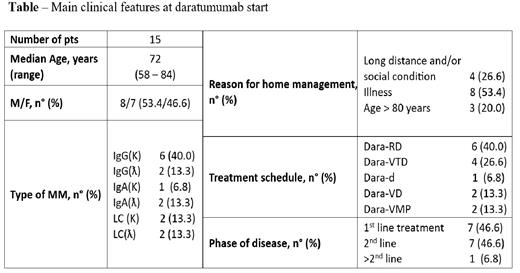Background Treatment of Multiple Myeloma (MM) is often difficult due to patient (pts) frailty, bone lesions/fractures that can hinder transport and/or long distance from the hospital. The availability in the Viterbo province of a Domiciliary Hematologic Care Unit (DHCU) allowed to overcome these difficulties.
Patients and methods Herein, the experience in 15 patients with MM treated as outpatients [10 at home (HC) and 5 in a Long Term Residential Accomodation (LTRA)] with subcutaneous (sc) daratumumab (dara) is reported, as part of the Myel-Home project. The initial 2 dara administrations, either intravenous or sc, were given in hospital to prevent side effects, while subsequent administrations were done as outpatients: the first dara administration as outpatient was done by nurse and physician, while subsequent ones by nurse only.
Results: The main clinical features of pts at baseline of dara initiation are shown in the Table. Different reasons for outpatient management were: advanced age (> 80 years) in 3 pts, illness related symptoms in 8 pts, social conditions and/or long distance in 4 pts. Distance from DHCU to pts home was < 20 Km in 4 cases ( 27%), ≥ 20 < 40 Km in 10 (66%) and ≥ 40 Km in 1 (7%). Different lines of treatment and different schemes are reported in the Table: among 7 pts treated in 1 st line, 3 were transplant eligible and 4 transplant ineligible. On the whole, 110 administrations of sc-dara were performed by DHCU nurses as outpatient: during and/or immediately after home administration, only one pt had adverse events (grade 2 allergic reaction according WHO), leading to dara permanent discontinuation after the 2nd dose at home. Main adverse events during the course of domiciliary treatment were infections (pneumonia in 4 pts, sepsis in 2, cystitis in 1) and deep vein thrombosis in 1 pts. Moreover, 4/5 patients (80%) in LTRA had infections (which were fatal in 3 of them) compared to 3/10 pts (30%) in HC with only 1 related death. Two pts were not yet evaluable for response and one pt discontinued early: among the evaluable 12 pts, 1 achieved a stringent complete remission and 4 a very good partial remission, with an overall response rate of 42%, 5 pts had a stable disease and 2 pts a disease progression. At the last follow-up, 8 pts are alive (2 waiting for transplant procedure) and 7 pts died (3 from disease progression, 3 from infective complications and 1 from heart disease).
Conclusions: Treatment at home with sc-dara in frail pts with MM is feasible and safe with improved quality of life, making possible a curative approach frontline as well as in advanced phases of disease also in subjects otherwise excluded by best available therapies or forced to long periods of hospitalization: it is worth of note that pts living in LTRA were at high risk of infective complications, thus limiting the advantages of a domiciliary management compared to pts living at our own house. In the next future, within the Myel-Home project, other monoclonal antibodies (belantamab-mafodotin and talquetamab) will be available for home administration.
Disclosures
Latagliata:Novartis: Honoraria; Janssen: Honoraria; Celgene: Honoraria; BMS: Honoraria.


This feature is available to Subscribers Only
Sign In or Create an Account Close Modal